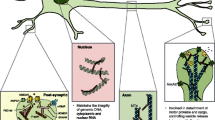Abstract
We previously reported that nonomolar concentrations of Taxol and several structurally diverse microtubule (MT)-stabilizing agents significantly enhanced the survival of neurons in the presence of fibrils of amyloid β peptide (Aβ). Pretreatment of neurons with MT-stabilizing drugs also blocked Aβ-induced activation of tau hyperphosphorylation. Although tau is a substrate for several kinases, we initially focused on cdk5, as this tau kinase has been shown to be activated in Aβ-treated neurons and Alzheimer’s disease (AD) brain. In an in vitro kinase assay, Taxol inhibited activation of cdk5 by Aβ. In addition, the proposed cellular cascade in which calpain activation leads to cleavage of the cdk5 regulator, p35, to the strong kinase activator p25 was also prevented. Taxol did not directly inhibit the activity of either cdk5 or calpain, indicating that other cellular components are required for the effect of the drug on Aβ activation of tau phosphorylation. Our results suggest that drugs that interact with MTs can alter signaling events in neurons, possibly because some MTs play a role in organizing protein complexes involved in responses to Aβ. Thus the cytoskeletal network may serve as a biosensor of cellular well-being.
Similar content being viewed by others
References
Ahlijanian M. K., Barrezueta N. X., Williams R. D., Jakowski A., Kowsz K. P., McCarthy S., et al. (2000) Hyperphosphorylated tau and neurofilament and cytoskeletal disruptions in mice overexpressing human p25, an activator of cdk5. Proc. Natl. Acad. Sci. USA 97, 2910–2915.
Alvarez A., Munoz J. P., and Maccioni R. B. (2001) A Cdk5-p35 stable complex is involved in the beta-amyloid-induced deregulation of Cdk5 activity in hippocampal neurons. Exp. Cell Res. 264, 266–274.
Alvarez A., Toro R., Caceres A., and Maccioni R. B. (1999) Inhibition of tau phosphorylating protein kinase cdk5 prevents beta-amyloid-induced neuronal death. FEBS Lett. 459, 421–426.
Billingsley M. L. and Kincaid R. L. (1997) Regulated phosphorylation and dephosphorylation of tau protein: effects on microtubule interaction, intracellular trafficking and neurodegeneration. Biochem. J. 323, 577–591.
Busciglio J., Lorenzo A., Yeh J., and Yanker B. A. (1995) β-Amyloid fibrils induce Tau phosphorylation and loss of microtubule binding. Neuron 14, 879–888.
Chen Y., Moore-Nichols D., Robertson T., Bechtel M., and Michaelis M. L. (1999) Effects of Aβ and microtubule-stabilizing drugs on the microtubule network in primary neurons. Soc. Neurosci. Abstr. 25, 2125.
Chen Y., Liu Y., Reiff E., Himes R., Georg G., and Michaelis M. L. (2000) Protection of primary neurons against Aβ-induced toxicity by structurally diverse microtubule-stabilizing drugs. Soc. Neurosci. 26, 664.13.
Chen Y., Hill S., Faibushevich A., and Michaelis M. L. (2001) Effects of Taxol on Aβ-induced activation of caspase-8 in primary neurons. Soc. Neurosci. Abstr. 27, 963.1.
Dhavan R. and Tsai L. H. (2001) A decade of cdk5. Nat. Rev. Mol. Cell. Biol. 2, 749–759.
Hutton M., Lendon C. L., Rizzu P., Baker M., Froelich S., Houlden H., et al. (1998) Association of missense and 5′-splice-site mutations in tau with the inherited dementia FTDP-17. Nature 393, 702–705.
Jackson G. R., Wiedau-Pazos M., Sang T.-K., Wagle N., Brown C. A., Massachi S., et al. (2002) Human wildtype Tau interacts with wingless pathway components and produces neurofibrillary pathology in Drosophila. Neuron 34, 509–519.
Lee K. Y., Clark A. W., Rosales J. L., Chapman K., Fung T., and Johnston R. N. (1999) Elevated neuronal Cdc2-like kinase activity in the Alzheimer disease brain. Neurosci. Res. 34, 21–29.
Lee M. S., Kwon Y. T., Li M., Peng J., Friedlander R. M., and Tsai L. H. (2000) Neurotoxicity induces cleavage of p35 to p25 by calpain. Nature 405, 360–364.
Lee V. M., Daughenbaugh R., and Trojanowski J. Q. (1994) Microtubule stabilizing drugs for the treatment of Alzheimer’s disease. Neurobiol. Aging 2(Suppl.), S87-S89.
Michaelis M. L., Ranciat N., Chen Y., Bechtel M., Ragan R., Hepperle M., et al. (1998a) Protection against β-amyloid toxicity in primary neurons by paclitaxel [Taxol®]. J. Neurochem. 70, 1623–1627.
Michaelis M. L., Chen Y., and Ranciat N. (1998b) Microtubule stabilization and protection against apoptosis in primary neurons. Soc. Neurosci. 24, 1457.
Niethammer M., Smith D. S., Ayala R., Peng J., Ko J., Lee M. S., et al. (2000) NUDEL is a novel Cdk5 substrate that associates with LIS1 and cytoplasmic dynein. Neuron 28, 697–711.
Patrick G. N., Zukerberg L., Nikolic M., de La Monte S., Dikkes P., and Tsai L. H. (1999) Conversion of p35 to p25 deregulates Cdk5 activity and promotes neurodegeneration. Nature 402, 615–622.
Patzke and Tsai (2002). Calpain-medicated cleavage of the cyclin-dependent kinase-5 activator p39 to p29. J. Biol. Chem. 277, 8054–8060.
Selkoe D. J. (2001) Clearing the brain’s amyloid cobwebs. Neuron 32, 177–180.
Sobue K., Agarwal-Mawal A., Li W., Sun W., Miura Y., and Paudel H. K. (2000) Interaction of neuronal Cdc2-like protein kinase with microtubule-associated protein tau. J. Biol. Chem. 275, 16,673–16,680.
Spillantini M. G., Murrell J. R., Goedert M., Farlow M. R., Klug A., and Ghetti B. (1998) Mutation in the tau gene in familial multiple system tauopathy with presenile dementia. Proc. Natl. Acad. Sci. USA 95, 7737–7741.
Taniguchi S., Fujita Y., Hayashi S., Kakita A., Takahashi H., Murayama S., et al. (2001) Calpain-mediated degradation of p35 to p25 in postmortem human and rat brains. FEBS Lett. 489, 46–50.
Trojanowski J. Q. and Lee V. M. (2000) “Fatal attractions” of proteins. A comprehensive hypothetical mechanism underlying Alzheimer’s disease and other neurodegenerative disorders. Ann. NY Acad. Sci. 924, 62–67.
Yoo B. C. and Lubec G. (2001) p25 protein in neurodegeneration. Nature 411, 763–764.
Author information
Authors and Affiliations
Corresponding author
Rights and permissions
About this article
Cite this article
Michaelis, M.L., Dobrowsky, R.T. & Li, G. Tau neurofibrillary pathology and microtubule stability. J Mol Neurosci 19, 289–293 (2002). https://doi.org/10.1385/JMN:19:3:289
Received:
Accepted:
Issue Date:
DOI: https://doi.org/10.1385/JMN:19:3:289




